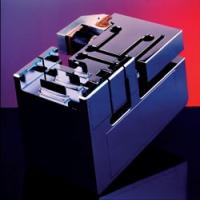Dec 20 2007
By means of X-ray interferometers, lengths down to the mm range can be measured with a resolution of less than one nm. The low translation velocity of the interferometers, which made their use in practice more difficult, could now be increased by a factor of 100 by exploiting the temporal correlation of singly interfering X-ray photons.
 The core piece of the X-ray interferometer, made from a silicon single crystal, furnishes the lattice parameter of silicon as an utmost precisely determined length scale.
The core piece of the X-ray interferometer, made from a silicon single crystal, furnishes the lattice parameter of silicon as an utmost precisely determined length scale.
X-ray interferometers can measure lengths in the mm range with sub-nm resolution, whereby the almost perfect crystal grid of high-purity silicon is used as a length scale. The dimensions of any sub-µm-structured samples are thereby compared with the lattice parameter of silicon (ë0~0.543... nm) which has been determined very precisely within the scope of the project for the new definition of the Avogadro constant. For metrological applications in connection with scanning probe microscopes, such measurements are of great importance.
Up to now, a further spreading of this method had, however, been impeded by the low translation velocities of only 1 nm/s to 10 nm/s. They are due to the limited intensity of typical laboratory X-ray sources: the necessary filtering of the periodic interference signal leads to a reduction in contrast which, in a classic measurement, requires a slow translation of the interferometer.
In a quantum-mechanical sense, however, interference occurs also in a strongly "diluted" stream of X-ray photons: Regarded as a wave packet, even single photons follow in their temporal impact on the detector the same probability which, in the case of sufficiently intense X-ray light, leads to the continuous signal whose period one wants to determine. This well-known quantum-mechanical fact is now exploited for a specific purpose: if one protocols the times at which the single photons hit the detector, one can, by means of a subsequent Fourier transform of this time series, determine very precisely the frequency at which the lattice periods were passed. At constant velocity, it is then possible to reconstruct the path information, and one obtains the same information as with the classic measurement, but in a much shorter amount of time.
Thus, translation velocities of up to 1000 nm/s could be realised. This method will in future not only be used in further improved measuring arrangements for the determination of the lattice parameter of silicon, but also for other length measurements in nanotechnology.